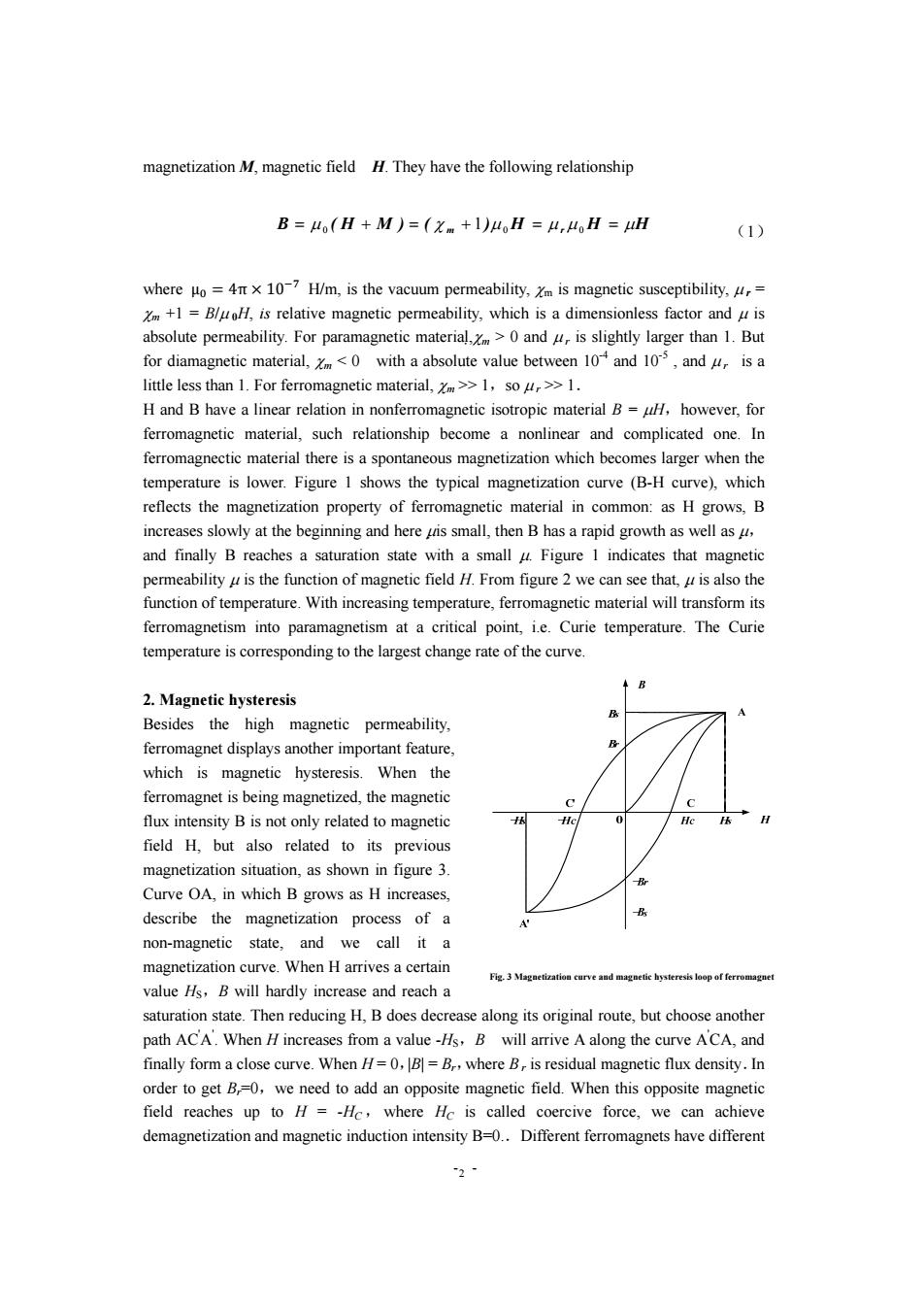正在加载图片...

magnetization M,magnetic field H.They have the following relationship B=uo(H+M)=(m+1)uoH=u,oH=H (1) where o=4nx 10-7 H/m,is the vacuum permeability,m is magnetic susceptibility,r= m+1=BluoH,is relative magnetic permeability,which is a dimensionless factor and u is absolute permeability.For paramagnetic material,>0 and u is slightly larger than 1.But for diamagnetic material,m with a absolute value between 10 and 105,and is a little less than 1.For ferromagnetic material,>>1,so>>1. H and B have a linear relation in nonferromagnetic isotropic material B=uH,however,for ferromagnetic material,such relationship become a nonlinear and complicated one.In ferromagnectic material there is a spontaneous magnetization which becomes larger when the temperature is lower.Figure 1 shows the typical magnetization curve (B-H curve),which reflects the magnetization property of ferromagnetic material in common:as H grows,B increases slowly at the beginning and here tis small,then B has a rapid growth as well as 4, and finally B reaches a saturation state with a small 4.Figure 1 indicates that magnetic permeability u is the function of magnetic field H.From figure 2 we can see that,u is also the function of temperature.With increasing temperature,ferromagnetic material will transform its ferromagnetism into paramagnetism at a critical point,i.e.Curie temperature.The Curie temperature is corresponding to the largest change rate of the curve. 2.Magnetic hysteresis Besides the high magnetic permeability, ferromagnet displays another important feature, which is magnetic hysteresis.When the ferromagnet is being magnetized,the magnetic flux intensity B is not only related to magnetic He 0 field H,but also related to its previous magnetization situation,as shown in figure 3. Curve OA,in which B grows as H increases, describe the magnetization process of a non-magnetic state,and we call it a magnetization curve.When H arrives a certain Fig.3 Magnetization curve and magnetic hvsteresis loop of ferromagnet value Hs,B will hardly increase and reach a saturation state.Then reducing H,B does decrease along its original route,but choose another path ACA.When H increases from a value-Hs,B will arrive A along the curve A'CA,and finally form a close curve.When H=0,B=B,,where B,is residual magnetic flux density.In order to get B,-0,we need to add an opposite magnetic field.When this opposite magnetic field reaches up to H=-Hc,where Hc is called coercive force,we can achieve demagnetization and magnetic induction intensity B-0..Different ferromagnets have different 2- - 2 magnetization M, magnetic field H. They have the following relationship B = μ 0 ( H + M ) = ( χ m + 1 )μ 0 H = μ r μ 0 H = μH (1) where µ ൌ 4π ൈ 10ି H/m, is the vacuum permeability, χm is magnetic susceptibility, μ r = χm +1 = B/μ 0H, is relative magnetic permeability, which is a dimensionless factor and μ is absolute permeability. For paramagnetic material,χm > 0 and μ r is slightly larger than 1. But for diamagnetic material, χm < 0 with a absolute value between 10-4 and 10-5 , and μ r is a little less than 1. For ferromagnetic material, χm >> 1,so μ r >> 1. H and B have a linear relation in nonferromagnetic isotropic material B = μH,however, for ferromagnetic material, such relationship become a nonlinear and complicated one. In ferromagnectic material there is a spontaneous magnetization which becomes larger when the temperature is lower. Figure 1 shows the typical magnetization curve (B-H curve), which reflects the magnetization property of ferromagnetic material in common: as H grows, B increases slowly at the beginning and here μis small, then B has a rapid growth as well as μ, and finally B reaches a saturation state with a small μ. Figure 1 indicates that magnetic permeability μ is the function of magnetic field H. From figure 2 we can see that, μ is also the function of temperature. With increasing temperature, ferromagnetic material will transform its ferromagnetism into paramagnetism at a critical point, i.e. Curie temperature. The Curie temperature is corresponding to the largest change rate of the curve. 2. Magnetic hysteresis Besides the high magnetic permeability, ferromagnet displays another important feature, which is magnetic hysteresis. When the ferromagnet is being magnetized, the magnetic flux intensity B is not only related to magnetic field H, but also related to its previous magnetization situation, as shown in figure 3. Curve OA, in which B grows as H increases, describe the magnetization process of a non-magnetic state, and we call it a magnetization curve. When H arrives a certain value HS,B will hardly increase and reach a saturation state. Then reducing H, B does decrease along its original route, but choose another path AC' A' . When H increases from a value -HS,B will arrive A along the curve A' CA, and finally form a close curve. When H = 0,|B| = Br,where B r is residual magnetic flux density.In order to get Br=0,we need to add an opposite magnetic field. When this opposite magnetic field reaches up to H = -HC , where HC is called coercive force, we can achieve demagnetization and magnetic induction intensity B=0..Different ferromagnets have different Fig. 3 Magnetization curve and magnetic hysteresis loop of ferromagnet